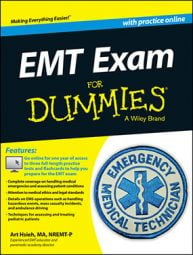You will need to know physiological differences in children for the EMT exam. Children have incredible demands for oxygen and nutrients as they grow and develop, due to metabolic needs. As a result, children breathe more quickly and their hearts beat faster as compared to adults; blood pressures tend to be lower. Check out the normal ranges in vital signs, based on age.
| Age | Pulse (bpm) | Respiratory rate (bpm) | Systolic BP (mm Hg) |
|---|---|---|---|
| Newborn | 120–180 | 30–50 | 60–80 |
| 6–12 months | 120–140 | 30–40 | 70–80 |
| 1–4 years | 100–110 | 20–30 | 80–95 |
| 5–7 years | 90–100 | 14–20 | 90–100 |
| 8–12 years | 80–100 | 12–20 | 100–110 |
| Over 12 years | 60–90 | 12–20 | 100–120 |
In general, the pediatric patient is usually healthy. Significant problems tend to arise when breathing and/or circulation is compromised. The body attempts to compensate for the problem for as long as possible and then rapidly decompensates when it can no longer do so. You want to be vigilant in observing the child’s level of mentation, breathing ability, and circulatory status, as these may change very quickly.
Really fast breathing and heart rates in children are usually compensatory signs, meaning that systems are striving to keep things working as close to normal as possible. A really slow breathing and/or heart rate is alarming — it means that the body is rapidly losing its ability to maintain control. If not corrected, respiratory and cardiac arrest are likely. Consider the following example questions.
A 20-month-old is awake and crying after a motor vehicle crash. She was restrained in her car seat. There is a contusion across her chest in the shape of the harness strap. Lung sounds are clear, her pulse rate is 130, and she is breathing at 30 times per minute. She is pale, warm, and dry. You should
(A)assist her breathing with a bag-valve mask and oxygen.
(B)continue your assessment.
(C)apply a bulky dressing to the chest wall, where the contusion is located.
(D)immobilize the patient to a long backboard.
The correct choice is (B). The child is crying, which is a good sign that she is breathing adequately. Her vital signs, though elevated, are within the normal range of a 20-month-old. She is ventilating adequately, making Choice (A) inappropriate.
You have no information to indicate an injury to the chest wall, Choice (C), and using a long board to immobilize a child that young, Choice (D), would require a lot of padding and adjustments to do it correctly. Other devices, specifically, a pediatric immobilization device, would work better.
A 2-year-old child is unresponsive. A parent found him unconscious in the bathroom with open pill bottles nearby. His respiratory rate is 10 breaths per minute, and his pulse rate is 60. His skin is cool, dry, and cyanotic. You should next
(A)assist his breathing with a bag-valve mask and oxygen.
(B)provide supplemental oxygen via a blow-by mask.
(C)determine the contents of the medication bottles.
(D)apply AED pads to the patient’s chest.
The correct answer is Choice (A). In this case, the patient’s breathing rate is too low for this age group. The lack of oxygen may be slowing down his heart rate to a dangerous level. He needs to be ventilated with oxygen quickly.
If the heart rate doesn’t increase within a few seconds to a minute of artificial ventilation, chest compressions may be needed. Choice (B) won’t deliver the oxygen to the cells because he is breathing too slow. You may need to perform Choice (C), but this will not help the child at this point. Choice (D) would be correct if the patient were in cardiac arrest — but he’s not.

